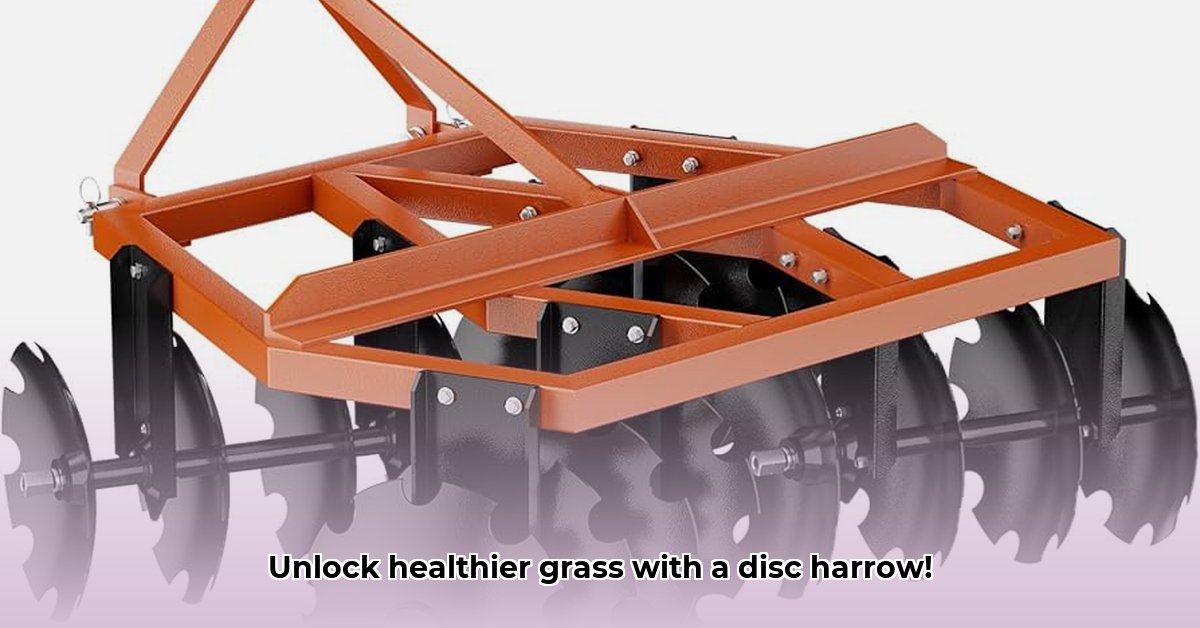
Got a bumpy, compacted lawn? A disc harrow attached to your lawn tractor can revitalize it. This guide will help you choose, prepare, use, maintain, and troubleshoot your disc harrow, improving soil health and creating a lusher, greener lawn. We'll also explore the environmental aspects of this practice within the broader context of sustainable agriculture. For more detailed information on lawn tractor harrows, check out this helpful resource.
Choosing the Right Disc Harrow
Selecting the correct disc harrow is vital for effectiveness and preventing damage. Consider these factors:
Size: The harrow's width should match your tractor's power. A width similar to your tractor's mower deck is generally a good starting point. Too wide, and your tractor will struggle; too narrow, and the job will take longer.
Weight: Heavier harrows till deeper, ideal for compacted soil, but ensure your tractor can handle the added weight, especially on inclines. Lighter harrows are suitable for lighter soils and less intense work.
Compatibility: Verify the harrow's hitch system is compatible with your lawn tractor. Improper attachment is dangerous.
Blade Type: Different blade styles work best for various soil types. Aggressive angles are effective on clay, while shallower angles are better for sandy soil.
| Harrow Model | Width (ft) | Weight (lbs) | Tractor HP Requirement | Best for Soil Type | Notes |
|---|---|---|---|---|---|
| "Easy-Glider" | 4 | 100 | 15-20 | Sandy, Loamy | Ideal for smaller lawns and lighter soils |
| "Power Plow" | 6 | 150 | 20-25 | Clay, Compacted Loam | Good all-around choice |
| "Rock Crusher" (HD) | 8 | 250 | 25+ | Extremely Compacted, Rocky Soil | For heavy-duty work, powerful tractors |
Preparing for Use: Safety First!
Before using your disc harrow, prioritize safety and proper preparation:
Assembly: Carefully assemble the harrow according to the manufacturer's instructions. Rushing can lead to errors and potential harm.
Blade Inspection: Examine the blades for sharpness and damage. Dull blades are ineffective and may damage your lawn. Sharpen or replace as needed.
Depth Adjustment: Begin with a shallow setting and gradually increase as needed. Excessive depth can damage your lawn.
Fluid Levels: Check and adjust your tractor's oil and coolant levels to prevent mechanical issues.
Safety Zone: Clear the working area of obstacles and ensure children and pets are safely away. Wear appropriate safety gear, including eye protection.
Using Your Disc Harrow Effectively
Effective harrowing requires proper technique:
Starting Point: Begin at one edge of your lawn, maintaining a consistent, steady speed. Avoid jerky movements.
Overlapping Passes: Overlap each pass by 50% to ensure even coverage.
Depth Control: Adjust depth as needed based on soil resistance. Monitor the soil condition to ensure it's being adequately worked.
Observation: Pay attention to the soil's response. If results are uneven, adjust the depth or overlap.
Maintenance and Storage
Proper maintenance extends the life of your disc harrow:
Cleaning: After each use, clean the blades and frame, removing debris with a wire brush or hose. This prevents corrosion.
Lubrication: Regularly lubricate moving parts according to the manufacturer's instructions to reduce friction and wear.
Storage: Store the harrow in a dry, covered area to protect against the elements.
Troubleshooting Common Issues
Here are solutions to common problems:
Uneven Harrowing: Check blade alignment, depth settings, and tractor speed. Adjust as needed.
Clogged Blades: Clean the blades using a wire brush or hose. Ensure proper depth and soil moisture (avoid excessively wet soil).
Environmental Considerations: Sustainable Lawn Care
Disc harrowing can improve soil aeration and water penetration, reducing the need for fertilizers and pesticides. However, misuse can cause soil erosion. Proper technique and consideration of soil type are crucial for minimizing environmental impact. Further research is needed to fully assess the long-term effects. Sustainable practices emphasize minimizing soil disturbance, so use this tool judiciously.
Key Takeaways:
- Proper selection and use of a disc harrow can significantly improve lawn health and soil structure.
- Safety precautions and regular maintenance are essential for efficient and safe operation.
- Understanding your soil type and adjusting techniques are key to successful and ecologically conscious use.
This guide provides a comprehensive overview of using a disc harrow for effective lawn care. Remember, responsible and informed use contributes to both a healthier lawn and a healthier environment.